The security industry has long suffered from a lack of accepted standards for the measurement of illumination distances. Published illuminator distances have been left to the subjective interpretation of individual manufacturers – resulting in varying claims.
This has always made it virtually impossible for consultants, installers and end-users to specify surveillance lighting with confidence to reliably compare products and achieve a consistent level of performance.
After facing this challenge for last 25 years, Raytec have tackled this problem head on by publishing the industry’s first open and transparent standard for surveillance lighting – POWERS.
The need for a lighting standard
In conjunction with your choice of camera and lens, the right lighting is the most powerful tool in helping you to achieve outstanding night-time performance from any professional video surveillance system. But with many different lighting solutions available in the market today, it can be difficult to accurately compare the performance of one illuminator to the next.
At one level, this may seem fairly straightforward – just look at the claimed distance performance from the manufacturer. However, until now there has been no standardized way to evaluate different illuminators and their performance claims – particularly infra-red lighting, and crucially, there have been no standardized testing methods for manufacturers to adhere to.
Traditional lighting industries i.e., street/ urban/ commercial lighting etc., have long established and standardized testing methods allowing all illuminators to be accurately compared. Sadly, this is simply not the case with lighting for surveillance and security.
Why is it so difficult to compare illuminators?
Manufacturers currently publish very limited technical information on the performance of their surveillance lighting – most only quoting a maximum distance. Without standardization, methods for calculating performance, especially distance, have always been left open to interpretation – leading to varying claims.
It is not uncommon to have two illuminators with a similar light output, that are quoted with wildly different maximum distances, because each manufacturer has a different opinion on what is classed as an acceptable image quality.
One manufacturer may take a realistic view and quote 150m (492 ft) but the other may take an overly optimistic view and rate this same product for 250m (820ft).
Since both products actually deliver exactly the same light output, it is obvious that the illuminator from the realistic manufacturer is going to provide a much better picture at its quoted distance.
But where does the agreed and acceptable performance benchmark lie?
Let’s look at this another way… same light output, different distance…which is correct?
1st Problem: Most manufacturers don’t provide calculation data to support their distance claims. Consider these images produced with two different infra-red illuminators (subject at 70m). Both could claim to deliver 70m+. Clearly one significantly outperforms the other with more clarity and detail – ultimately leading to better subject identification and analytics. But it’s all subjective – without calculation data, we don’t know how much light each illuminator is actually delivering at its maximum distance.
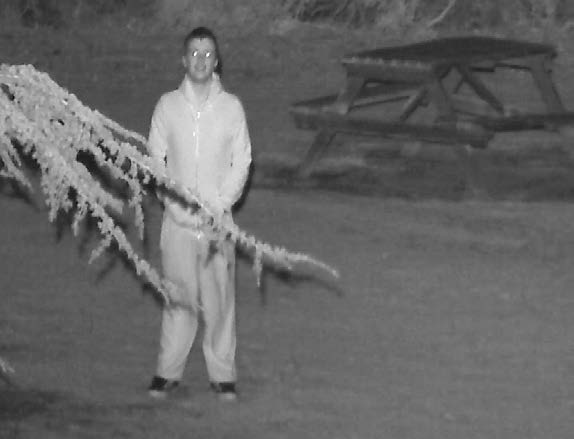
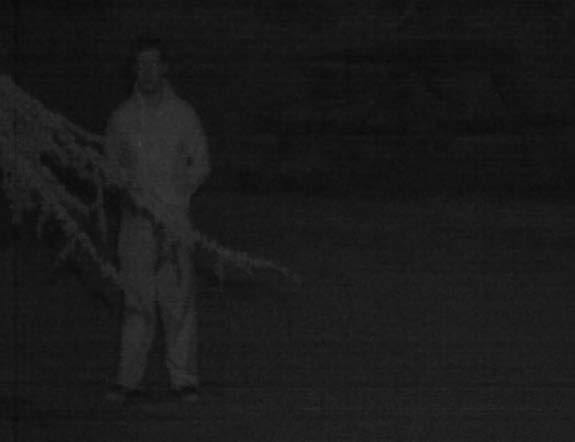 2nd Problem: Most manufacturers don’t state the camera specification used. This is especially important if you are comparing one illuminator against another that promises almost identical image quality at a similar distance.
2nd Problem: Most manufacturers don’t state the camera specification used. This is especially important if you are comparing one illuminator against another that promises almost identical image quality at a similar distance.
How do you know that both illuminators are truly equal?
In reality, one illuminator may have actually been tested with a much higher performance camera – which in effect boosts its capability. Beware – this is often how a lower performance/ smaller illuminator can ‘appear’ to outperform a higher performance illuminator on paper.
To claim better distances a lighting manufacturer may have used or accepted a much more expensive and sensitive camera, a much more expensive and higher performing lens, a more highly reflective surface and a low quality picture, to quantify the published distance.
Illuminator performance – the important information
Distance is only one area of lighting performance to consider. Other criteria to consider include, angle, flexibility and adaptability, integration capability, consumption, environmental impact, reliability, lifetime, warranty, customer support, and lighting partner credentials.
In short, when looking at an illuminator for video surveillance, people want to know:
- How far does the illuminator shine?
- How wide does it shine?
- Is it efficient and reliable?
- What features does it have?
- Will the manufacturer support me with warranty/ certification/ technical support?
And so the POWERS standard was born – to answer all of these questions and more.
Introducing the POWERS standard
As the world leader in LED lighting, Raytec has taken the lead and published the industry’s first lighting standard for video surveillance – ‘POWERS.’
The standard is based on decades of practical industry experience and sets a lighting performance benchmark backed up by consistent scientific testing methods.
It highlights the relevant criteria to consider, enabling security professionals to more easily specify and reliably compare the performance of different illuminators. It also helps them gain an understanding as to how their chosen lighting product will perform.
‘P’ for Peak power
The first ‘P’ of POWERS stands for Peak Power. It is the measurement that should be used by all manufacturers to scientifically calculate their quoted performance distances and is therefore one of the most important areas of the standard. The Peak Power of an illuminator is measured at the centre point of the beam using an appropriate light or power meter. At Raytec, we measure all our units at 3 metres from the light source.
Why Peak Power?
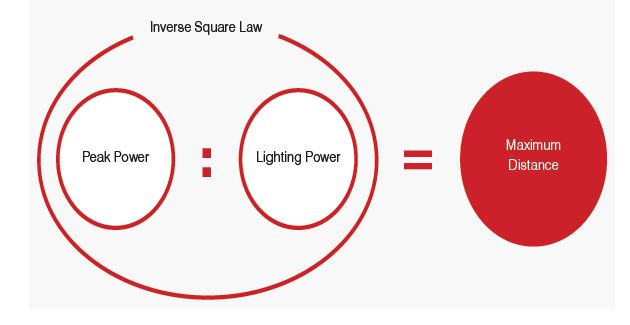 The peak power of your illuminator and the lighting power you wish to achieve on scene, together with the principles of inverse square law (a law at the heart of scientific lighting calculations), are used to calculate the true usable distance of your illuminator.
The peak power of your illuminator and the lighting power you wish to achieve on scene, together with the principles of inverse square law (a law at the heart of scientific lighting calculations), are used to calculate the true usable distance of your illuminator.
Calculating maximum distances should be based on adhering to a consistent level of lighting power on scene at your required distance – a vitally important part of the POWERS standard. This is to ensure that you achieve the same quality of image from your illuminator, every time.
But what lighting levels should you adhere to?
 Raytec recommend a minimum lighting power on scene of 0.35 μW/cm2 (microwatts per square centimetre) for infra-red and 3 lux for white-light. We calculate all of our illumination distances to these light levels using a medium performance camera.
Raytec recommend a minimum lighting power on scene of 0.35 μW/cm2 (microwatts per square centimetre) for infra-red and 3 lux for white-light. We calculate all of our illumination distances to these light levels using a medium performance camera.
Working to these light levels with a medium performance camera, you will be able to achieve high quality, consistent images every time and comply with the POWERS standard.
We always slightly under specify our distances so you KNOW you’ll always achieve what we quote on our data sheets. Take care – you may need to apply more light to support higher megapixel cameras or if you are zooming in over long distances.
Precise distances are camera and lens dependent
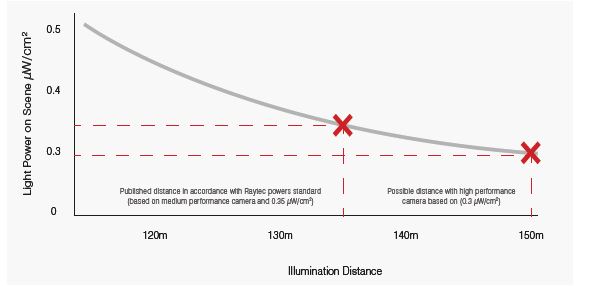 Lighting performance is ultimately dictated by your chosen camera and lens. By calculating our Raytec distances based on a medium performance camera it means that they are easily achievable by most camera systems. But in theory you could exceed our distances by using the latest generation low light cameras which often require less light on scene to generate greater distances.
Lighting performance is ultimately dictated by your chosen camera and lens. By calculating our Raytec distances based on a medium performance camera it means that they are easily achievable by most camera systems. But in theory you could exceed our distances by using the latest generation low light cameras which often require less light on scene to generate greater distances.
Remember – a lighting manufacturer can only control the light, not the system….so tell us which camera specification you are using and we can help you to calculate accurate distances specific to your installation.
Our distance promise
Want to be sure that your illuminator is going to deliver what it promises? Ask us for POWERS Specification Data for our latest illuminators and specify your lighting installation with confidence.
We guarantee that every Raytec illuminator delivers a minimum of 0.35μW/cm2 (Infra-Red) or 3 lux (White-Light) power on scene at our maximum quoted distance – ensuring the best image quality every time.
If your manufacturer can’t tell you how they’ve calculated their distances – how can you trust their claims?
‘O’ of Powers – Overall Power
The Overall Power Output (total flux) is an important measurement for calculating the efficiency of an illuminator, that (light output) can be compared to total power consumption (power usage).
It is typically measured in an integrating sphere by an independent testing house or can be calculated from first principles, and it is measured in Watts (IR) or Lumens (WL).
‘W’ of Power – Width/ Angle
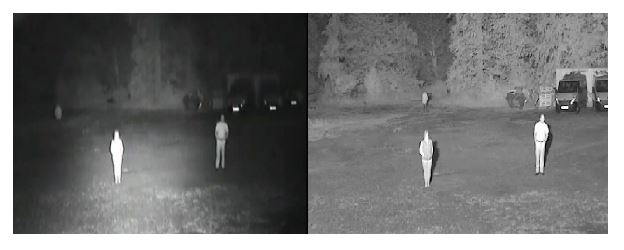 Determining width/ angle is another important area which has historically been left open to the interpretation of the manufacturer consider the two images below, both manufacturers could claim a 60° beam angle.
Determining width/ angle is another important area which has historically been left open to the interpretation of the manufacturer consider the two images below, both manufacturers could claim a 60° beam angle.
Whilst the manufacturer on the left could technically claim that their illuminator does actually provide light throughout the full scene, we can clearly see that the image on the right is far superior, evenly covering the full width and depth of the scene with no dark or bright areas.
A standard measurement to determine width/ angle is the ‘Full Width, Half Maximum’ (FWHM) approach. It is well-known in many traditional lighting industries and this is the approach adopted in the POWERS standard.
It takes the peak power reading in the centre point of the beam and then records the angle at either side of centre at which lighting power has dropped to 50%. This measurement helps to provide an understanding of the beam angle provided by illuminator.
Raytec quote our angles based on 50% of the peak power. The Raytec POWERS standard provides information on the angles achieved at both 50% and 25% of peak power to offer more data for specifiers.
With this data, you will be able to accurately evaluate the quality of the beam spread and it will help understand how to reliably compare the angle output of different lighting products.
‘E’ of Power – Environmental
LED lighting is renowned as being extremely efficient, delivering huge energy savings over alternative lighting sources. But not all LED lighting are the same – so it is important to understand the key facts about your illuminator and your manufacturer.
Illuminator efficiency
Knowing the power consumption of your illuminator will not only indicate your running costs, but also your energy and CO2 footprint. As a benchmark, Raytec’s longest distance illuminator covering 700m consumes only 120W.
Environmentally approved
It is also important that your manufacturer operates in an environmentally friendly way. Raytec is an ISO14001 accredited organisation for the management of environmental issues.
Mindful manufacturing
Fully recyclable, Raytec packaging is ultra lean whilst providing the utmost protection. Raytec also adheres to WEEE requirements for the safe collection, recovery and recycling of electronic waste.
Approved materials
It is important that your illuminator has a good environmental impact and meets requirements for restricted materials and substances. All Raytec illuminators adhere to the European directives of RoHS (Restriction of Hazardous Substances) and REACH (Registration, Evaluation, Authorisation and Restriction of Chemicals).
Eye safety
Raytec products are independently tested and comply with international eye safety standards.
‘R’ of Powers – Reliability
Product lifetime is key
Knowing how the quoted operational life of your illuminator has been calculated is essential for understanding its true reliability, build quality and how it will perform over time.
Methods for calculating product lifetime have historically been very subjective. A standard calculation to determine end of life, followed by POWERS (and well-known in traditional lighting industries), is the L70/ B50 approach.
The L70/ B50 approach determines the end of an illuminator’s life to be when a batch of 50% of the LEDs (in a single illuminator) has dropped to below 70% of their original power.
 The degradation of an LED illuminator is mainly affected by the running temperature of the LEDs, known as junction temperature (Tj) . This is dependent on many factors – mainly thermal management design – but also on LED type, drive current and ambient temperature, to name a few.
The degradation of an LED illuminator is mainly affected by the running temperature of the LEDs, known as junction temperature (Tj) . This is dependent on many factors – mainly thermal management design – but also on LED type, drive current and ambient temperature, to name a few.
All Raytec illuminators are designed to deliver an operational lifetime of 100,000 hours+.
In the given figure above, the blue line represents an example of Raytec illuminator with an LED Tj of 105°C. The light output hits 70% of the original power output after 100,000 hours – our quoted lifetime.
Compare this to the brown line, showing an alternative illuminator with an LED Tj of 125°C. With a fairly small increase in LED junction temperature, operational life is reduced by 80% to less than 20,000 hours.
Durability
Being able to rely on the durability of your illuminator out in the field is essential. Raytec illuminators are typically IP66 rated, impact resistant and are designed to withstand most global environments. We also provide illuminators that are purpose designed for extreme temperatures, salinity, vibration and toughness for extreme applications.
The temperature range of your illuminator is a good indicator of quality. Raytec illuminators operate from -50 to +50˚C (-58 to 122°F) as standard with temperatures up to +75˚C (167°F) possible.
Quality assured
It’s important to trust in the quality of your illuminator, including its materials and build process. All of Raytec’s products and procedures are ISO 9001 certified for quality assurance – the world renowned standard for recognising the ability to meet customer and regulatory requirements.
All Raytec illuminators are also CE marked and conform with European safety directives. Raytec hold various other global certifications including UL, FCC, and others (product specific).
Warranty and support
The warranty and support provided with your illuminator are an important part of the ‘total product’ package. You should consider the warranty duration, terms and any exclusions. All Raytec illuminators offer an industry leading 5 year warranty including free technical support.
‘S’ for Specification/ Features
It is also important that your chosen illuminator can provide the level of functionality needed to meet your installation requirements.
As an absolute minimum, your illuminator should provide photocell and photocell adjust; power adjust; telemetry control; and adjustable/ interchangeable beam angles.
Desired features include hot-spot reduction technology; photocell following output; and PoE capability, and advanced features include hand-held remote control; timer function; IP addressability; hybrid functionality; and others.
The future of the POWERS lighting standard
POWERS is an open and transparent standard to provide customers with consistent and reliable information on which to base their choice of illuminator. In time, we hope that all reputable manufacturers will commit to measuring their surveillance lighting performance in accordance with the POWERS standard.
To fully support security professionals in choosing the correct illuminator, where information is not made available by other manufacturers, Raytec offers testing of third party products in accordance with the POWERS standard.
POWERS today
The POWERS method is used to calculate distances and specifications for all Raytecs current A-line products and will be used for all future Raytec products. POWERS data is freely available on request for consultants and specifiers.
We will continue to work closely with other manufacturers and customers to evolve the standard over time in accordance with technology advances, market trends and customer requirements. At Raytec we are working hard to ensure that the standard becomes widely adopted and used for the benefit of everyone across the industry.
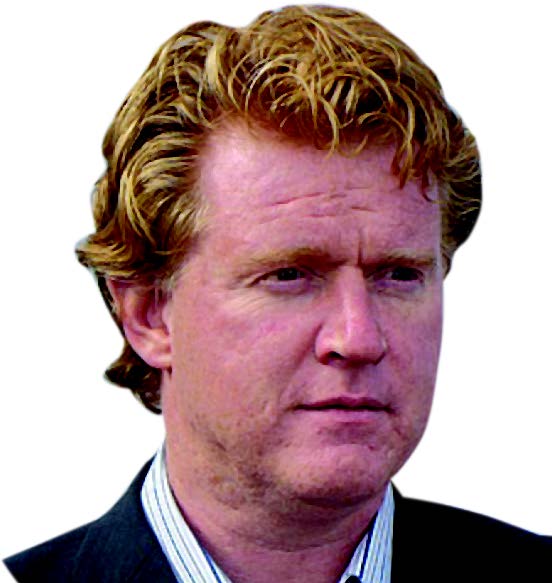

– Tony Whiting and David Lambert – Raytec Managing Directors (Joint)